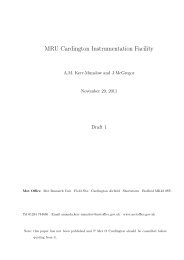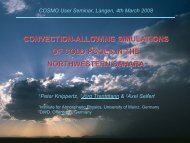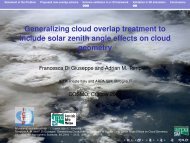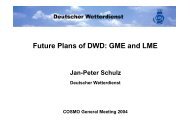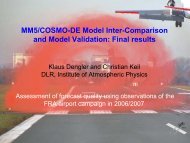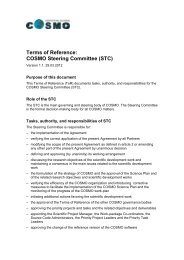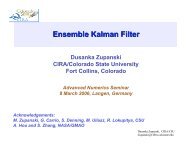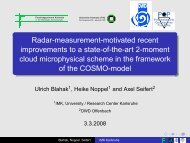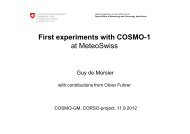Synopsis of FLake Routinesâ - COSMO model
Synopsis of FLake Routinesâ - COSMO model
Synopsis of FLake Routinesâ - COSMO model
You also want an ePaper? Increase the reach of your titles
YUMPU automatically turns print PDFs into web optimized ePapers that Google loves.
<strong>Synopsis</strong> <strong>of</strong> <strong>FLake</strong> Routines ∗<br />
February 15, 2006<br />
The synopsis presents a short description <strong>of</strong> the program units <strong>of</strong> the lake <strong>model</strong> <strong>FLake</strong><br />
and <strong>of</strong> the atmospheric surface-layer parameterization scheme SfcFlx that is used to<br />
compute fluxes <strong>of</strong> momentum and heat at the air-water interface. A detailed scientific<br />
description <strong>of</strong> <strong>FLake</strong> and <strong>of</strong> SfcFlx is given in Mironov (2005) and Mironov et al.<br />
(2005). Further useful comments can be found directly in the source codes <strong>of</strong> <strong>FLake</strong><br />
and <strong>of</strong> SfcFlx. Some results from single-column experiments with <strong>FLake</strong> and SfcFlx<br />
are described in Mironov et al. (2003). A thermodynamic sea ice <strong>model</strong> (parameterization<br />
scheme) for the global NWP system GME (Majewski et al. 2002) <strong>of</strong> the German<br />
Weather Service (DWD), that is broadly similar to the ice parameterization scheme <strong>of</strong><br />
<strong>FLake</strong>, is described in Mironov and Ritter (2004).<br />
<strong>FLake</strong> can be used in a stand-alone mode as a single-column lake <strong>model</strong>, or as a lake<br />
parameterization module in three-dimensional numerical weather prediction (NWP) or<br />
climate <strong>model</strong>ling systems. A convenient means to organise communication between<br />
<strong>FLake</strong> and a driving <strong>model</strong> that calls <strong>FLake</strong> is provided by <strong>FLake</strong> Interface. <strong>FLake</strong><br />
Interface is a communication routine. Its details differ with the application, and it is<br />
the user responsibility to organise the use <strong>of</strong> <strong>FLake</strong> in the most convenient way. An<br />
example <strong>of</strong> <strong>FLake</strong> Interface for single-column applications is briefly described in what<br />
follows.<br />
Conventions<br />
The synopsis follows typographic conventions outlined below.<br />
Bold<br />
Small Caps<br />
Slanted<br />
is used for file names.<br />
is used for names <strong>of</strong> modules and routines.<br />
is used for names <strong>of</strong> variables, parameters, arrays, etc.<br />
The FORTRAN 90 source code <strong>of</strong> <strong>FLake</strong> and SfcFlx contains a number <strong>of</strong> comment<br />
lines. Lines embraced/marked with “! dm” are DM’s comments that may appear to<br />
be helpful to a user. Lines embraced/marked with “! dev” are to be replaced (in the<br />
future versions <strong>of</strong> <strong>FLake</strong>) as improved physical parameterizations are developed and<br />
tested. Lines embraced/marked with “! dbg” are used for debugging purposes only.<br />
Lines embraced/marked with “! nu” are not used.<br />
∗ Corresponding author address: Dmitrii V. Mironov, Deutscher Wetterdienst, Meteorologische<br />
Analyse und Modellierung, Kaiserleistr. 29/35, D-63067 Offenbach am Main, Germany. Phone +49-<br />
69-8062 2705, fax +49-69-8062 3721, e-mail dmitrii.mironov@dwd.de.
Modules flake and SfcFlx described below contain a number <strong>of</strong> routines (subroutines<br />
and functions). The source codes <strong>of</strong> those routines are stored in separate include<br />
files that have an extension incf. In the <strong>FLake</strong> version implemented into the limitedarea<br />
NWP system LM (Steppeler et al. 2003) <strong>of</strong> DWD, no separate incf files are used.<br />
References<br />
Majewski, D., D. Liermann, P. Prohl, B. Ritter, M. Buchhold, T. Hanisch, G. Paul,<br />
W. Wergen, and J. Baumgardner, 2002: Icosahedral-hexagonal gridpoint <strong>model</strong><br />
GME: description and high-resolution tests. Mon. Weather Rev., 130, 319–338.<br />
Mironov, D. V., 2005: Parameterization <strong>of</strong> lakes in numerical weather prediction. Part<br />
1: Description <strong>of</strong> a lake <strong>model</strong>. Deutscher Wetterdienst, Offenbach am Main, Germany.<br />
(manuscript is available from the author)<br />
Mironov, D. V., and co-authors, 2005: Parameterization <strong>of</strong> lakes in numerical weather<br />
prediction. Part 2: Single-column tests. In preparation.<br />
Mironov, D., and B. Ritter, 2004: A New Sea Ice Model for GME. Technical Note,<br />
Deutscher Wetterdienst, Offenbach am Main, Germany, 12 pp.<br />
Mironov, D., A. Terzhevik, F. Beyrich, E. Heise, and H. Lohse, 2003: A two-layer<br />
lake <strong>model</strong> for use in numerical weather prediction. Proc. <strong>of</strong> the Baltic HIRLAM<br />
Workshop, 17 – 20 November 2003, St. Petersburg, Russia, 83–85.<br />
Steppeler, J., G. Doms, U. Schättler, H. W. Bitzer, A. Gassmann, U. Damrath, and<br />
G. Gregoric, 2003: Meso-gamma scale forecasts using the non-hydrostatic <strong>model</strong><br />
LM. Meteorol. Atmos. Phys., 82, 75–96.<br />
2
<strong>FLake</strong> Interface<br />
<strong>FLake</strong> Interface represents a convenient means to organise communication between<br />
<strong>FLake</strong> and a driving <strong>model</strong> that calls <strong>FLake</strong>. Details <strong>of</strong> <strong>FLake</strong> Interface differ with<br />
the application, and it is the user responsibility to organise the use <strong>of</strong> <strong>FLake</strong> in the<br />
most convenient way. An example <strong>of</strong> <strong>FLake</strong> Interface for single-column applications<br />
is described below. <strong>FLake</strong> Interface is a communication routine that does not contain<br />
any Flake physics. It does, however, contain a number <strong>of</strong> variables that have to do<br />
with the physics <strong>of</strong> the atmosphere-lake interface, namely, the surface albedo <strong>of</strong> water,<br />
ice and snow with respect to solar radiation. It also contains the optical characteristics<br />
<strong>of</strong> water, ice and snow. Values <strong>of</strong> these variables may be computed within <strong>FLake</strong><br />
Interface. The details are given below.<br />
SUBROUTINE flake interface<br />
Modules used: data parameters, flake, flake albedo ref,<br />
flake derivedtypes, flake parameters, flake paramoptic ref, SfcFlx<br />
Contained in: a user-specified module, can also be used as a stand-alone routine<br />
Called by: a driving <strong>model</strong><br />
File: src flake interface 1D.f90<br />
The input arguments with INTENT (IN):<br />
dMsnowdt in rate <strong>of</strong> snow accumulation (kg·m −2 s −1 )<br />
I atm in solar radiation flux at the surface (W·m −2 = kg·s −3 )<br />
Q atm lw in long-wave radiation flux from the atmosphere (W·m −2 = kg·s −3 )<br />
height u in<br />
height tq in<br />
height above the lake surface where the wind speed is measured (m)<br />
height where temperature and humidity are measured (m)<br />
U a in wind speed at z=height u in (m·s −1 )<br />
T a in<br />
q a in<br />
air temperature at z=height tq in (K)<br />
air specific humidity at z=height tq in (dimensionless)<br />
P a in surface air pressure (N·m −2 = kg·m −1·s −2 )<br />
depth w<br />
fetch<br />
depth bs<br />
T bs<br />
lake depth (m)<br />
wind fetch (m)<br />
depth <strong>of</strong> the thermally active layer <strong>of</strong> bottom sediments (m)<br />
temperature at the outer edge <strong>of</strong> the thermally active layer <strong>of</strong> bottom<br />
sediments (K)<br />
par Coriolis the Coriolis parameter (s −1 )<br />
del time<br />
T snow in<br />
time step (s)<br />
temperature at the air-snow interface (K)<br />
3
T ice in<br />
T mnw in<br />
T wML in<br />
T bot in<br />
T B1 in<br />
C T in<br />
h snow in<br />
h ice in<br />
h ML in<br />
H B1 in<br />
T sfc p<br />
temperature at the snow-ice or air-ice interface (K)<br />
mean temperature <strong>of</strong> the water column (K)<br />
mixed-layer temperature (K)<br />
temperature at the water-bottom sediment interface (K)<br />
temperature at the bottom <strong>of</strong> the upper layer <strong>of</strong> the sediment (K)<br />
shape factor with respect to the temperature pr<strong>of</strong>ile in the thermocline<br />
(dimensionless)<br />
snow thickness (m)<br />
ice thickness (m)<br />
thickness <strong>of</strong> the mixed-layer (m)<br />
thickness <strong>of</strong> the upper layer <strong>of</strong> bottom sediments (m)<br />
surface temperature at the previous time step (K) that is equal to<br />
the temperature <strong>of</strong> the surface <strong>of</strong> water, <strong>of</strong> ice or <strong>of</strong> snow<br />
The input/output arguments with INTENT (INOUT):<br />
albedo water<br />
albedo ice<br />
albedo snow<br />
opticpar water<br />
opticpar ice<br />
opticpar snow<br />
water surface albedo with respect to solar radiation (dimensionless)<br />
ice surface albedo with respect to solar radiation (dimensionless)<br />
snow surface albedo with respect to solar radiation (dimensionless)<br />
optical characteristics <strong>of</strong> water (variable <strong>of</strong> type opticpar medium)<br />
optical characteristics <strong>of</strong> ice (variable <strong>of</strong> type opticpar medium)<br />
optical characteristics <strong>of</strong> snow (variable <strong>of</strong> type opticpar medium)<br />
The output arguments with INTENT (OUT):<br />
T snow out<br />
T ice out<br />
T mnw out<br />
T wML out<br />
T bot out<br />
T B1 out<br />
C T out<br />
h snow out<br />
h ice out<br />
h ML out<br />
H B1 out<br />
temperature at the air-snow interface (K)<br />
temperature at the snow-ice or air-ice interface (K)<br />
mean temperature <strong>of</strong> the water column (K)<br />
mixed-layer temperature (K)<br />
temperature at the water-bottom sediment interface (K)<br />
temperature at the bottom <strong>of</strong> the upper layer <strong>of</strong> the sediment (K)<br />
shape factor with respect to the temperature pr<strong>of</strong>ile in the thermocline<br />
(dimensionless)<br />
snow thickness (m)<br />
ice thickness (m)<br />
thickness <strong>of</strong> the mixed-layer (m)<br />
thickness <strong>of</strong> the upper layer <strong>of</strong> bottom sediments (m)<br />
4
T sfc n<br />
the updated surface temperature (K), that is the temperature <strong>of</strong><br />
the surface <strong>of</strong> water, <strong>of</strong> ice or <strong>of</strong> snow, as the case may be<br />
Description: <strong>FLake</strong> Interface organises a time step <strong>of</strong> <strong>FLake</strong>. <strong>FLake</strong> routines are called<br />
and various quantities are computed in an appropriate order. The USE statements ensure<br />
a correct data exchange between various <strong>FLake</strong> routines. A few local variables declared<br />
in flake interface are used to store intermediate results. flake interface<br />
is a plug-compatible routine from the viewpoint <strong>of</strong> a driving <strong>model</strong>. All one has to do<br />
to organise time stepping is to call flake interface in a DO loop with respect to<br />
time, passing the necessary information through the input arguments and getting the<br />
results through the output arguments <strong>of</strong> flake interface. In this way, <strong>FLake</strong> can<br />
essentially be used as a black box.<br />
A time step <strong>of</strong> <strong>FLake</strong> is organised as follows. First, the values <strong>of</strong> albedo <strong>of</strong> water,<br />
<strong>of</strong> ice and <strong>of</strong> snow with respect to solar radiation, and the optical characteristics<br />
<strong>of</strong> water, <strong>of</strong> ice and <strong>of</strong> snow are set/computed. Notice these variables are the<br />
input arguments <strong>of</strong> flake interface with INTENT (INOUT). They can be either<br />
passed to flake interface from the driving <strong>model</strong>, or set/computed within<br />
flake interface, e.g. using default values <strong>of</strong>fered by <strong>FLake</strong>. In order to compute<br />
the ice surface albedo with respect to solar radiation, an empirical formulation is used<br />
that relates the ice albedo to the ice surface temperature. That formulation is meant<br />
to implicitly account, in a rather approximate way, for the seasonal changes <strong>of</strong> the ice<br />
albedo (see Mironov and Ritter 2004, 2005). Although provision is made to <strong>model</strong><br />
the evolution <strong>of</strong> snow cover over the lake ice, the snow module <strong>of</strong> <strong>FLake</strong> has not been<br />
sufficiently tested and is not used at the moment. The snow albedo is formally set<br />
equal to the ice albedo. Parameters opticpar ice opaque and opticpar snow opaque<br />
(module flake paramoptic ref) are used to specify the optical characteristics <strong>of</strong><br />
ice and snow. This is a recommended choice.<br />
Next, the initial values <strong>of</strong> <strong>FLake</strong> prognostic variables are set. That is, <strong>FLake</strong> variables<br />
with the suffix “ p flk” are assigned the values <strong>of</strong> the corresponding input arguments<br />
<strong>of</strong> flake interface with the suffix “ in”.<br />
Then, the rate <strong>of</strong> snow accumulation is set by assigning the <strong>FLake</strong> variable dMsnowdt<br />
flk a value <strong>of</strong> the input argument dMsnowdt in. As mentioned above, the<br />
snow module <strong>of</strong> <strong>FLake</strong> is not used at the time being. No switch is required to deactivate<br />
the snow module. All one has to do is to pass a zero value <strong>of</strong> dMsnowdt in to<br />
flake interface. This choice can be hard-coded by explicitly setting dMsnowdt flk<br />
to zero in flake interface.<br />
Then, the fluxes <strong>of</strong> heat and <strong>of</strong> momentum are computed. The downward flux <strong>of</strong> solar<br />
radiation and the downward long-wave radiation flux from the atmosphere are external<br />
parameters for the lake <strong>model</strong>. They do not depend <strong>of</strong> the surface temperature and<br />
are, therefore, not part <strong>of</strong> the solution. These fluxes are provided to flake interface<br />
by the driving <strong>model</strong> through the input arguments I atm in and Q atm lw in. Fluxes<br />
<strong>of</strong> long-wave radiation from the surface, <strong>of</strong> sensible and latent heat and <strong>of</strong> momentum<br />
depend on the surface temperature and are, therefore, part <strong>of</strong> the solution. These fluxes<br />
are computed in flake interface. Notice the sign <strong>of</strong> fluxes. The SfcFlx routines<br />
assign a positive sign to fluxes if they are directed upwards, whereas in the <strong>FLake</strong><br />
5
outines the downward fluxes are considered to be positive.<br />
The <strong>FLake</strong> variable I atm flk is assigned a value <strong>of</strong> the input argument I atm in. The<br />
subroutine flake radflux is then called to compute the flux <strong>of</strong> solar radiation at<br />
various depths and the solar-radiation fluxes averaged over the mixed layer and over<br />
the thermocline are computed. Notice that the effect <strong>of</strong> albedo is accounted for within<br />
flake radflux, whereas I atm in is the incident flux <strong>of</strong> solar radiation at the lake<br />
surface.<br />
As different from solar heating that has a volumetric character, the sum <strong>of</strong> the longwave<br />
radiation fluxes and <strong>of</strong> the fluxes <strong>of</strong> sensible and latent heat enters the <strong>FLake</strong><br />
equations through the boundary condition at the lake surface. This surface flux is<br />
stored in the <strong>FLake</strong> variable Q w flk. Q w flk is first assigned a value <strong>of</strong> the input<br />
argument Q atm lw in. Then the upward long-wave radiation flux from the surface<br />
computed with the function SfcFlx lwradwsfc is subtracted. Then the subroutine<br />
SfcFlx momsenlat is called to compute fluxes <strong>of</strong> momentum and <strong>of</strong> sensible and<br />
latent heat. The surface momentum flux is used to compute the friction velocity in<br />
the surface layer <strong>of</strong> water. The fluxes <strong>of</strong> sensible and latent heat are added (with the<br />
appropriate sign) to Q w flk. The flux calculation is completed by setting the heat<br />
flux at the air-snow interface, Q snow flk, and the heat flux at the snow-ice or airice<br />
interface, Q ice flk, as dependent on whether ice and/or snow is present. If ice is<br />
present, Q w flk is reset to zero.<br />
Then the subroutine flake driver is called that advances <strong>FLake</strong> variables one time<br />
step. After this call, the <strong>FLake</strong> prognostic variables with the suffix “ n flk” contain<br />
updated values.<br />
Finally, the output arguments <strong>of</strong> flake interface, i.e. the variables with the suffix<br />
“ out”, are assigned the values <strong>of</strong> the corresponding <strong>FLake</strong> variables with the suffix<br />
“ n flk”. The updated surface temperature T sfc n is set equal to either the watersurface<br />
temperature, or to the surface temperature <strong>of</strong> ice or snow. Since the skin effects<br />
are not considered in the present version <strong>of</strong> <strong>FLake</strong>, the water surface temperature is<br />
equal to the mixed-layer temperature.<br />
Given the above example <strong>of</strong> <strong>FLake</strong> Interface for single-column applications, developing<br />
a <strong>FLake</strong> Interface for use in a three-dimensional NWP, climate <strong>model</strong>ling or other<br />
numerical prediction system is straightforward. The above calculations are organised<br />
in a DO loop over horizontal grid-points, where the calculations are actually performed<br />
for the grid-points where lakes are present. In this way, a driving atmospheric <strong>model</strong><br />
should call <strong>FLake</strong> Interface only once, passing the required variables and parameters<br />
to <strong>FLake</strong> Interface as two-dimensional fields. A user can use her/his own routines to<br />
compute fluxes <strong>of</strong> momentum and <strong>of</strong> heat instead <strong>of</strong> the SfcFlx routines.<br />
6
Routines <strong>of</strong> the Lake Model <strong>FLake</strong><br />
MODULE data parameters<br />
Modules used: none<br />
Contains: none<br />
Used by: all <strong>FLake</strong> and SfcFlx modules and procedures<br />
File: data parameters.f90<br />
Description: In this module, that is taken from LM, global kind parameters are defined.<br />
Values <strong>of</strong> integer parameters ireals and iintegers are set, using intrinsic procedures<br />
SELECTED REAL KIND and KIND, respectively.<br />
MODULE flake<br />
Modules used: data parameters<br />
Contains: SUBROUTINE flake driver, SUBROUTINE flake radflux,<br />
FUNCTION flake buoypar, FUNCTION flake snowdensity,<br />
FUNCTION flake snowheatconduct<br />
Used by: flake interface<br />
File: flake.f90<br />
Description: Main program unit <strong>of</strong> the lake <strong>model</strong> <strong>FLake</strong>. <strong>FLake</strong> variables that are directly<br />
accessible to all <strong>FLake</strong> procedures contained in this module are declared. These<br />
variables should be made accessible to <strong>FLake</strong> Interface (or to any other user-specified<br />
routine that calls <strong>FLake</strong> procedures) through the respective USE statement. All variables<br />
declared in module flake have a suffix “ flk”. Two variables are declared for each<br />
<strong>FLake</strong> prognostic quantity. Those with the suffix “ p flk” contain values <strong>of</strong> prognostic<br />
quantities at the previous time step, whereas the variables with the suffix “ n flk”<br />
contain updated values.<br />
MODULE flake albedo ref<br />
Modules used: data parameters<br />
Contains: none<br />
Used by: flake interface<br />
File: flake albedo ref.f90<br />
Description: Reference (default) values <strong>of</strong> albedo for the lake water, lake ice, and snow<br />
are specified. As in flake paramoptic ref, two ice categories, viz. white ice and<br />
blue ice, and two snow categories, viz. dry snow and melting snow, are used. A value <strong>of</strong><br />
the dimensionless constant c albice MR in the interpolation formula for the ice surface<br />
albedo with respect to solar radiation is specified (see flake interface).<br />
7
MODULE flake configure<br />
Modules used: data parameters<br />
Contains: none<br />
Used by: flake driver<br />
File: flake configure.f90<br />
Description: Switches that configure <strong>FLake</strong> are set. At the moment, the only switch<br />
used is lflk botsed use. Setting lflk botsed use=.TRUE. indicates that the bottomsediment<br />
scheme is used to compute the depth penetrated by the thermal wave, the<br />
temperature at this depth, and the bottom heat flux. Otherwise, the heat flux at the<br />
water-bottom sediment interface is set to zero, the depth penetrated by the thermal<br />
wave is set to a default value specified in this module (parameter rflk depth bs ref),<br />
and the temperature at that depth is set to the temperature <strong>of</strong> maximum density <strong>of</strong><br />
the fresh water.<br />
MODULE flake derivedtypes<br />
Modules used: data parameters<br />
Contains: none<br />
Used by: flake interface, flake paramoptic ref, flake radflux<br />
File: flake derivedtypes.f90<br />
Description: Derived type opticpar medium used by other <strong>FLake</strong> program units is<br />
defined. Parameters (variables) <strong>of</strong> type opticpar medium are used to specify optical<br />
characteristics <strong>of</strong> lake water, assuming an exponential decay law for the flux <strong>of</strong> solar<br />
radiation. Each parameter (variable) <strong>of</strong> type opticpar medium consists <strong>of</strong> an integer<br />
(KIND=iintegers) nband optic that specifies the number <strong>of</strong> wave-length bands used,<br />
and <strong>of</strong> two real (KIND=ireals) one-dimensional arrays <strong>of</strong> length nband optic max that<br />
specify fractions <strong>of</strong> total solar radiation flux and extinction coefficients for each wavelength<br />
band, frac optic and extincoef optic, respectively. An integer (KIND=iintegers)<br />
parameter nband optic max is a maximum allowable value <strong>of</strong> the wave-length bands.<br />
MODULE flake parameters<br />
Modules used: data parameters<br />
Contains: none<br />
Used by: flake interface, flake buoypar, flake driver, flake radflux,<br />
flake snowdensity, flake snowheatconduct, SfcFlx<br />
File: flake parameters.f90<br />
Description: Values <strong>of</strong> empirical (disposable) constants and parameters <strong>of</strong> <strong>FLake</strong>, <strong>of</strong><br />
several thermodynamic parameters, and <strong>of</strong> security constants are specified. Recommended<br />
values are given. They are determined on the basis <strong>of</strong> physical reasoning,<br />
8
empirical evidence, and sensitivity experiments. A user should exercise caution when<br />
changing values <strong>of</strong> disposable parameters <strong>of</strong> <strong>FLake</strong> (see <strong>FLake</strong> description).<br />
MODULE flake paramoptic ref<br />
Modules used: data parameters, flake derivedtypes<br />
Contains: none<br />
Used by: flake interface<br />
File: flake paramoptic ref.f90<br />
Description: Reference (default) values <strong>of</strong> the optical characteristics <strong>of</strong> the lake water,<br />
lake ice, and snow are specified, assuming an exponential decay law for the flux <strong>of</strong><br />
solar radiation. These default values may be used if no information about the optical<br />
characteristics <strong>of</strong> the lake in question is available. In the simplest one-band exponential<br />
approximation <strong>of</strong> the decay law, parameter opticpar water ref, the extinction<br />
coefficient for water is set to a large value, leading to the absorption <strong>of</strong> 95% <strong>of</strong> the incoming<br />
radiation within the uppermost 1 m <strong>of</strong> the lake water. An example <strong>of</strong> two-band<br />
approximation, parameter opticpar water trans, suitable for transparent lake water is<br />
also given. Very large values <strong>of</strong> the extinction coefficients for ice and snow, parameters<br />
opticpar ice opaque and opticpar snow opaque, respectively, are used to prevent<br />
penetration <strong>of</strong> the solar radiation through the snow-ice cover. The above parameters<br />
specifying the optical characteristics <strong>of</strong> the medium in question are <strong>of</strong> derived type opticpar<br />
medium that is defined in module flake derivedtypes. In case the number<br />
<strong>of</strong> wave-length bands used (integer nband optic) exceeds one, a user must ensure that<br />
fractions <strong>of</strong> total solar radiation flux add up to 1. Unused fractions (i.e. elements <strong>of</strong> the<br />
array frac optic with indices from nband optic+1 through nband optic max) are set to<br />
zero. Unused extinction coefficients are set to a large value. Notice that the first extinction<br />
coefficient (element <strong>of</strong> the array extincoef optic with index 1) is treated as typical<br />
extinction coefficient for the lake in question. It is used in subroutine flake driver to<br />
estimate the equilibrium depth <strong>of</strong> the surface-cooling-driven convectively-mixed layer<br />
whose deepening is arrested by the volumetric solar heating.<br />
SUBROUTINE flake driver<br />
Modules used: flake parameters, flake configure (data parameters is used<br />
by flake)<br />
Contained in: MODULE flake<br />
Called by: flake interface<br />
File: flake driver.incf<br />
Description: Main driving routine <strong>of</strong> the lake <strong>model</strong> <strong>FLake</strong> where computations are<br />
performed. It advances <strong>FLake</strong> variables one time step. At the moment, the Euler<br />
explicit scheme is used.<br />
Computations start with setting the time-rate-<strong>of</strong>-change <strong>of</strong> prognostic variables to zero<br />
9
(local variables with the suffix “ dt”), and setting prognostic variables (suffix “ n flk”)<br />
to their values at the previous time step (suffix “ p flk”). This is a security measure<br />
required to avoid spurious changes <strong>of</strong> prognostic variables when <strong>FLake</strong> is used within a<br />
three-dimensional driving <strong>model</strong>, e.g. to avoid spurious generation <strong>of</strong> ice at the neighbouring<br />
lake points. Next, the heat flux through the ice-water interface, a generalised<br />
heat flux scale utilised in calculations <strong>of</strong> the convective boundary-layer evolution, and<br />
the heat flux through the water-bottom sediment interface are computed. Then, computations<br />
proceed to advance the thickness and the temperature <strong>of</strong> ice and <strong>of</strong> snow, the<br />
mean temperature <strong>of</strong> the water column, the mixed-layer depth, the mixed-layer temperature,<br />
the bottom temperature, and the shape factor with respect to the temperature<br />
pr<strong>of</strong>ile in the thermocline. Then, the depth <strong>of</strong> the upper layer <strong>of</strong> bottom sediments<br />
penetrated by the thermal wave and the temperature at that depth are computed.<br />
Finally, the lake surface temperature is updated. That is, it is set equal to either the<br />
water-surface temperature, or to the surface temperature <strong>of</strong> ice or snow.<br />
The source code <strong>of</strong> flake driver is furnished with comment lines that should help a<br />
user to understand the code structure. See also the scientific description <strong>of</strong> <strong>FLake</strong> in<br />
Mironov (2005).<br />
The input arguments <strong>of</strong> flake driver with INTENT (IN) are the lake depth (m),<br />
depth <strong>of</strong> the thermally active layer <strong>of</strong> bottom sediments (m), temperature at the outer<br />
edge <strong>of</strong> the thermally active layer <strong>of</strong> bottom sediments (K), the Coriolis parameter<br />
(s −1 ), typical extinction coefficient <strong>of</strong> the lake water with respect to solar radiation<br />
(m −1 ), time step (s), and the surface temperature at the previous time step (K) that<br />
is equal to the temperature <strong>of</strong> the surface <strong>of</strong> water, <strong>of</strong> ice or <strong>of</strong> snow.<br />
The output argument <strong>of</strong> flake driver with INTENT (OUT) is the updated surface<br />
temperature (K), that is the temperature <strong>of</strong> the surface <strong>of</strong> water, <strong>of</strong> ice or <strong>of</strong> snow,<br />
as the case may be. Other results <strong>of</strong> calculations are available to the <strong>FLake</strong> routines<br />
through the variables declared in module flake (suffix “ flk”).<br />
SUBROUTINE flake radflux<br />
Modules used: flake derivedtypes, flake parameters (data parameters is<br />
used by flake)<br />
Contained in: MODULE flake<br />
Called by: flake interface<br />
File: flake radflux.incf<br />
Description: Computes the flux <strong>of</strong> solar radiation at the snow-ice, ice-water, air-water,<br />
mixed layer-thermocline and water column-bottom sediment interfaces, the mean radiation<br />
flux over the mixed layer, and the mean radiation flux over the thermocline.<br />
An exponential decay law for the flux <strong>of</strong> solar radiation is used.<br />
The input arguments <strong>of</strong> flake radflux with INTENT (IN) are the lake depth (m),<br />
albedo <strong>of</strong> the water surface (dimensionless), albedo <strong>of</strong> the ice surface (dimensionless),<br />
albedo <strong>of</strong> the snow surface (dimensionless), and three parameters <strong>of</strong> derived type opticpar<br />
medium, namely, opticpar water, opticpar ice and opticpar snow, that specify op-<br />
10
tical characteristics <strong>of</strong> water, ice and snow, respectively. Derived type opticpar medium<br />
is defined in module flake derivedtypes. Variables used in calculations are declared<br />
in module flake (suffix “ flk”).<br />
Subroutine flake radflux has no output arguments. Results <strong>of</strong> calculations are<br />
available to other routines through the variables declared in module flake (suffix<br />
“ flk”).<br />
FUNCTION flake buoypar<br />
Contained in: MODULE flake<br />
Modules used: flake parameters (data parameters is used by flake)<br />
Called by: flake driver<br />
File: flake buoypar.incf<br />
Description: Computes the buoyancy parameter (m·s −2 K −1 ) as function <strong>of</strong> the water<br />
temperature (K). A quadratic equation <strong>of</strong> state for the fresh-water is used.<br />
FUNCTION flake snowdensity<br />
Contained in: MODULE flake<br />
Modules used: flake parameters (data parameters is used by flake)<br />
Called by: flake driver, flake snowheatconduct<br />
File: flake snowdensity.incf<br />
Description: Computes snow density (kg·m −3 ) as function <strong>of</strong> snow thickness (m). A<br />
simple empirical approximation is utilised that is similar to the approximation used in<br />
an old two-layer soil <strong>model</strong> <strong>of</strong> LM. It should be replaced as an improved parameterization<br />
becomes available.<br />
FUNCTION flake snowheatconduct<br />
Contained in: MODULE flake<br />
Modules used: flake parameters (data parameters is used by flake)<br />
Called by: flake driver<br />
File: flake snowheatconduct.incf<br />
Description: Computes snow heat conductivity (J·m −1·s −1 K −1 = kg·m·s −3 K −1 ) as function<br />
<strong>of</strong> snow thickness (m). A simple empirical approximation is utilised that is similar<br />
to the approximation used in an old two-layer soil <strong>model</strong> <strong>of</strong> LM. It should be replaced<br />
as an improved parameterization becomes available.<br />
11
Routines <strong>of</strong> the Surface-Layer Scheme SfcFlx<br />
MODULE SfcFlx<br />
Modules used: data parameters, flake parameters<br />
Contains: SUBROUTINE SfcFlx momsenlat, SUBROUTINE SfcFlx roughness,<br />
FUNCTION SfcFlx lwradatm, FUNCTION SfcFlx lwradwsfc,<br />
FUNCTION SfcFlx rhoair, FUNCTION SfcFlx satwvpres,<br />
FUNCTION SfcFlx spechum, FUNCTION SfcFlx wvpreswetbulb<br />
Used by: flake interface<br />
File: SfcFlx.f90<br />
Description: Main program unit <strong>of</strong> the atmospheric surface-layer parameterization<br />
scheme SfcFlx. Values <strong>of</strong> dimensionless constants and parameters, <strong>of</strong> several thermodynamic<br />
parameters, and <strong>of</strong> security and utility constants are specified. A number<br />
<strong>of</strong> variables are declared. Notice that several parameters specified in module<br />
flake parameters are used.<br />
SUBROUTINE SfcFlx momsenlat<br />
Contained in: MODULE SfcFlx<br />
Modules used: none (data parameters is used by SfcFlx)<br />
Called by: flake interface<br />
File: SfcFlx momsenlat.incf<br />
Description: Computes fluxes <strong>of</strong> momentum and <strong>of</strong> sensible and latent heat at the airwater<br />
or air-ice (air-snow) interface. The Monin-Obukhov similarity relations are used<br />
to compute turbulent fluxes. The surface roughness lengths with respect to wind speed,<br />
potential temperature and specific humidity are computed in SfcFlx roughness.<br />
The transcendental equations are solved iteratively using the Newton method. A “1/3”<br />
power law in terms <strong>of</strong> Nusselt and Rayleigh numbers is used to compute fluxes <strong>of</strong><br />
sensible and latent heat in case <strong>of</strong> free convection. In case <strong>of</strong> strong static stability in<br />
the surface air layer, when the gradient Richardson number exceeds its critical value<br />
and the Monin-Obukhov similarity relations yield zero fluxes, crude estimates <strong>of</strong> fluxes<br />
<strong>of</strong> momentum and <strong>of</strong> sensible and latent heat are obtained, assuming that the transport<br />
<strong>of</strong> momentum, heat and mass in the surface air layer is controlled by the molecular<br />
transfer mechanisms. A decision between turbulent and molecular fluxes and between<br />
fluxes in forced and free convection is made on the basis <strong>of</strong> flux magnitude. For example,<br />
two estimates <strong>of</strong> the sensible heat flux are computed, one with the Monin-Obukhov<br />
similarity relations and the other one with the free convection heat-mass transfer law.<br />
The estimate is then chosen that is greater in magnitude. This procedure ensures a<br />
gradual transition between various flow regimes.<br />
The input arguments <strong>of</strong> SfcFlx momsenlat with INTENT (IN) are height above<br />
the surface where the wind speed is measured/computed (m), height above the surface<br />
12
where temperature and humidity are measured/computed (m), (typical) wind fetch<br />
(m), wind speed (m·s −1 ), air temperature (K), air specific humidity (dimensionless),<br />
surface temperature (K), surface air pressure (N·m −2 = kg·m −1·s −2 ), and ice thickness<br />
(m). The surface temperature is the temperature <strong>of</strong> the surface <strong>of</strong> water, <strong>of</strong> ice or <strong>of</strong><br />
snow, as the case may be.<br />
The output arguments <strong>of</strong> SfcFlx momsenlat with INTENT (OUT) are momentum<br />
flux (N·m −2 = kg·m −1·s −2 ), sensible heat flux (W·m −2 = kg·s −3 ), latent heat flux<br />
(W·m −2 = kg·s −3 ), and flux <strong>of</strong> water vapour (kg·m −2 s −1 ). All fluxes are positive when<br />
directed upwards.<br />
SUBROUTINE SfcFlx roughness<br />
Contained in: MODULE SfcFlx<br />
Modules used: none (data parameters is used by SfcFlx)<br />
Called by: SfcFlx momsenlat<br />
File: SfcFlx roughness.incf<br />
Description: Computes the water-surface or the ice-surface roughness lengths with<br />
respect to wind speed, potential temperature, and specific humidity. Apart from the<br />
roughness lengths, the fetch-dependent Charnock parameter and the threshold value<br />
<strong>of</strong> friction velocity in the surface air layer, that is used to discriminate between the<br />
aerodynamically smooth and aerodynamically rough regimes <strong>of</strong> the flow over the water<br />
surface, are computed.<br />
The input arguments <strong>of</strong> SfcFlx roughness with INTENT (IN) are typical wind<br />
fetch (m), wind speed (m·s −1 ), friction velocity in the surface air layer (m·s −1 ), and ice<br />
thickness (m).<br />
The output arguments <strong>of</strong> SfcFlx roughness with INTENT (OUT) are the roughness<br />
length (m) with respect to wind speed, the roughness length (m) with respect to<br />
potential temperature, the roughness length (m) with respect to specific humidity,<br />
the fetch-dependent Charnock parameter (dimensionless), and the threshold value <strong>of</strong><br />
friction velocity (m·s −1 ) in the surface air layer.<br />
FUNCTION SfcFlx lwradatm<br />
Contained in: MODULE SfcFlx<br />
Modules used: none (data parameters is used by SfcFlx)<br />
Called by: – (any user-specified routine)<br />
File: SfcFlx lwradatm.incf<br />
Description: Computes the downward long-wave radiation flux (W·m −2 = kg·s −3 ) from<br />
the atmosphere as function <strong>of</strong> air temperature (K), water vapour pressure (N·m −2 =<br />
kg·m −1·s −2 ), total cloud cover (fraction <strong>of</strong> one), and low-level cloud cover (fraction <strong>of</strong><br />
one). Simple empirical formulations for the water-vapour correction function and the<br />
13
cloud correction function are used. If no data on low-level cloud cover is available, that<br />
is only total cloud cover is known, the low-level cloud cover must be set to a negative<br />
value (e.g. −1).<br />
FUNCTION SfcFlx lwradwsfc<br />
Contained in: MODULE SfcFlx<br />
Modules used: none (data parameters is used by SfcFlx)<br />
Called by: flake interface<br />
File: SfcFlx lwradwsfc.incf<br />
Description: Computes the upward long-wave radiation flux (W·m −2 = kg·s −3 ) from<br />
the surface as function <strong>of</strong> temperature (K). The surface emissivity with respect to the<br />
long-wave radiation is specified in module SfcFlx.<br />
FUNCTION SfcFlx rhoair<br />
Contained in: MODULE SfcFlx<br />
Modules used: none (data parameters is used by SfcFlx)<br />
Called by: SfcFlx momsenlat<br />
File: SfcFlx rhoair.incf<br />
Description: Computes the air density (kg·m −3 ) as function <strong>of</strong> temperature (K), specific<br />
humidity (dimensionless), and pressure (N·m −2 = kg·m −1·s −2 ).<br />
FUNCTION SfcFlx satwvpres<br />
Contained in: MODULE SfcFlx<br />
Modules used: none (data parameters and flake parameters are used by SfcFlx)<br />
Called by: SfcFlx momsenlat<br />
File: SfcFlx satwvpres.incf<br />
Description: Computes saturation water vapour pressure (N·m −2 = kg·m −1·s −2 ) over<br />
the water surface or over the ice surface as function <strong>of</strong> temperature (K) and ice thickness<br />
(m). A minimum ice thickness used to discriminate between the water surface and the<br />
ice surface is specified in module flake parameters.<br />
FUNCTION SfcFlx spechum<br />
Contained in: MODULE SfcFlx<br />
Modules used: none (data parameters is used by SfcFlx)<br />
14
Called by: SfcFlx momsenlat<br />
File: SfcFlx spechum.incf<br />
Description: Computes specific humidity (dimensionless) as function <strong>of</strong> water vapour<br />
pressure (N·m −2 = kg·m −1·s −2 ) and air pressure (N·m −2 = kg·m −1·s −2 ).<br />
FUNCTION SfcFlx wvpreswetbulb<br />
Contained in: MODULE SfcFlx<br />
Modules used: none (data parameters is used by SfcFlx)<br />
Called by: – (any user-specified routine)<br />
File: SfcFlx wvpreswetbulb.incf<br />
Description: Computes water vapour pressure (N·m −2 = kg·m −1·s −2 ) as function <strong>of</strong><br />
air temperature (K), wet-bulb temperature (K), saturation vapour pressure (N·m −2 =<br />
kg·m −1·s −2 ) at wet-bulb temperature, and air pressure (N·m −2 = kg·m −1·s −2 ).<br />
15




